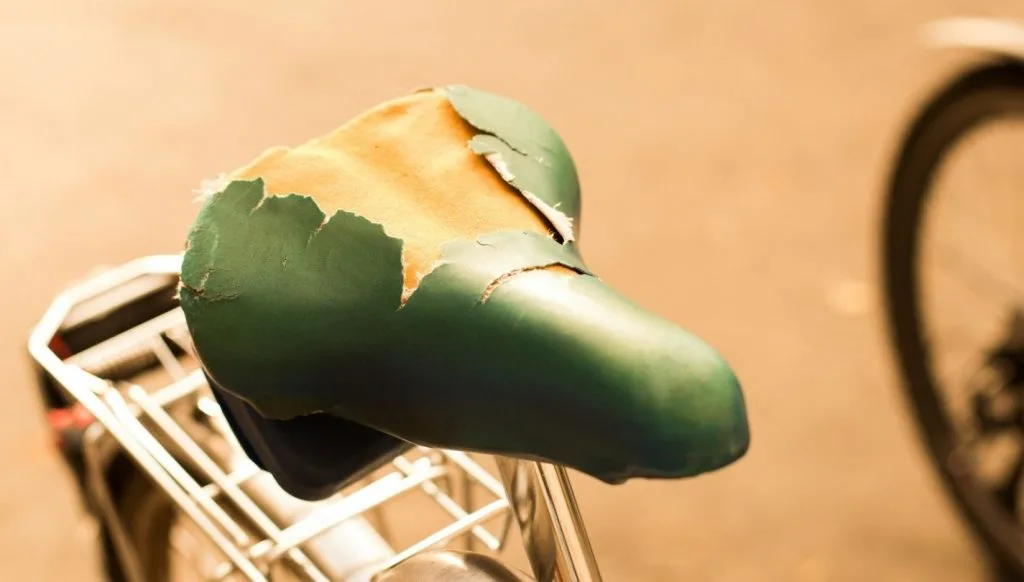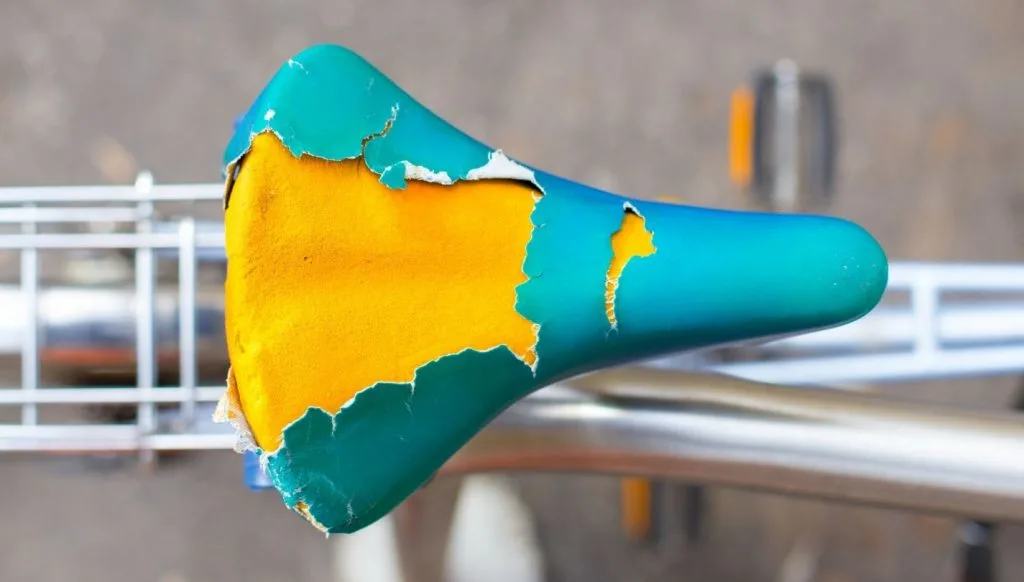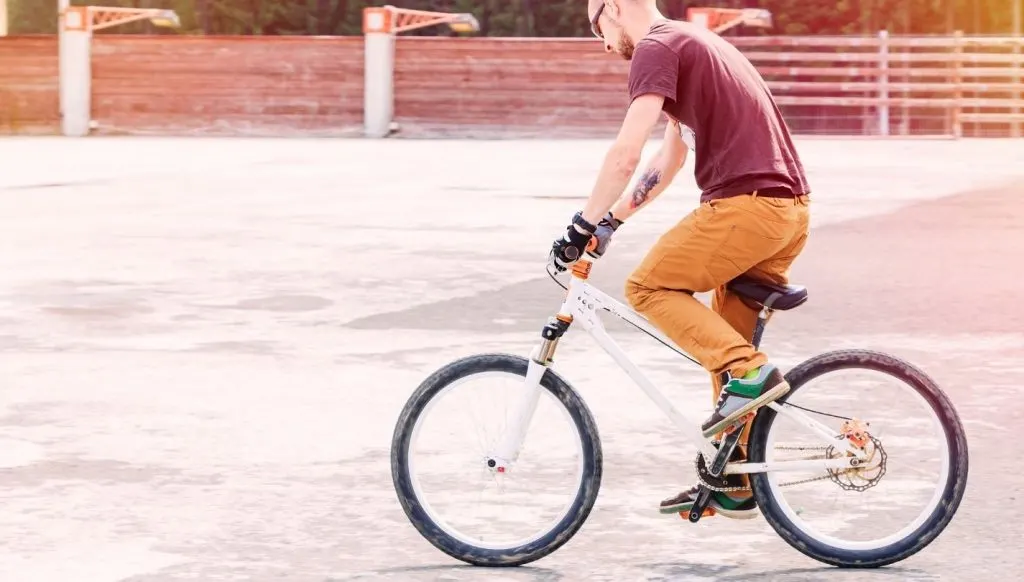
Your bike saddle is one of the essential parts of your bike. It connects you to the bike in every way, from your feet on the pedals to your hands on the handlebars. Imagine riding your bike without the saddle…..ouch!
You’ll know when you need a new saddle if:
- You have cycled more than 12,000 miles
- If the saddle is no longer a good fit
- If there is obvious wear and tear
There will come a time when you feel you need a new saddle, whether you are moving up to more competitive riding or your old saddle is finally ready to go to that great bike in the sky. This article will help you decide if your saddle needs replacing, or if you can continue using it for quite some time…
How Often Should you Replace a Bike Saddle?
Before looking at some of the reasons why you’d need a new saddle, let’s quickly look at how often you’d need to replace it under regular use.
Professional riders would replace their saddles every 6200 miles due to their time in the saddle, and this is necessary to maintain consistent performance and comfort during races and training.
For the average rider, replacing the saddle every 9300 to 12000 miles as the shell and cover will deteriorate after this mileage.
While the saddle would be not unusable at this point, you may find that you start to get uncomfortable and possibly experience saddle sores or similar indications of saddle wear.
What Causes Saddle To Wear?
Over time, the gel and foam become to lose their shape and strength, and the friction of shorts, especially the baggy types as worn by MTB riders, wears through the cover and could allow water from the rider’s clothing into the saddle.
Split base saddles can also lean or tilt to one side after a while, and while you can adapt slowly as hard spots develop in the padding, a tilting saddle will affect your position on the bike.
The Importance of Getting Your Saddle Properly Fitted
Everyone has a slightly different body type and structure. While we are all the same, factors like height, leg and arm length, seat bone structure, and flexibility significantly affect your ability to ride effectively.
While it may seem that ‘a saddle is a saddle’, this is NOT the case. Over the last ten years, one of the great benefits of the improved cycling technology is that computer-aided analysis has given great insight into saddle and rider dynamics.
This has led to a far better understanding for bike technicians, saddle manufacturers, and professional fitters on measuring and fitting riders for the saddle best suited to their body geometry.
In turn, this has to lead to significant improvements in saddle design and a wide variety of saddle styles to suit every type of rider and to accommodate all levels of skill and budgets.
Not only that, but riders themselves have come to understand the importance of getting the right saddle so they can enjoy pain-free riding over their riding career.
Now, let’s look at the tell-tale signs of when you need a new saddle…
How to Know you Need a New Saddle
- You Need a New Saddle If You’ve Crashed
A crash while riding can result in the saddle getting damaged, and it’s pretty straightforward to determine whether you need a new saddle after a crash.
Check the cover of your saddle first
This is an obvious indication of damage, so if the cover is compromised and water or sweat could enter through cracks on the cover surface, then it’s time to get a new one. According to Fizik’s Carlo Ferrero, liquid getting into the saddle could compromise the foam performance of your saddle.
Check for structural damage
The saddle structure should also not be crushed, and it should be in the same shape as when it was first fitted. Any apparent structural damage requires a new saddle, resulting in the inability to support the rider’s weight and risk failure during riding.
Check the metal rails
While a bent rail may appear to be still sound, it changes the body’s position slightly, which will require the rider to adapt to the different positions, which can lead to discomfort or injury over time.
Check the Carbon Rails
If your bike saddle has carbon rails, any splintering or cracking, especially near the seat post or exit/ entry to the saddle base, would require a new saddle.
- You’d Need a New Saddle from Wear And Tear

Time, friction, weight, and the effects of sunlight, water, dirt take a toll on the saddle, and over time it causes saddle performance to deteriorate. Where you see discoloration, cracking, or creaking, and especially if it becomes uncomfortable – these are all signs that you need to go saddle shopping!
Saddle foam and gel can also shift shape over time, leading to a gradual change in their original position and affecting both the riding position and the rider’s comfort.
- Body Changes Mean Saddle Changes
As you get older, your body will change due to losing or gaining muscle, fat or improve or lose joint mobility and body flexibility.
All of these impact the relationship your body has with your bike and your saddle. Remember that a properly fitted saddle to suit both body and riding style is super-important to ensure a safe and comfortable ride and mitigate any risk of injury.
The pelvic area of your body holds nerves, muscles, and ligaments that need to be correctly seated on the bike to avoid discomfort and damage. If you are experiencing any growing pain, don’t delay – check your saddle and if that doesn’t help, chat to your doctor.
- Change Your Saddle for More Comfort
After riding for some years, you may decide that you want a more comfortable ride. Many riders go from the more demanding riding, faster, more competitive pace to an easier-paced riding style.
The importance of getting a proper saddle that fits your body comfortably and allows you to get good pedaling technique on the bike can not be understated.
You might decide to swap your road bike or mountain for a hybrid to take a more leisurely approach to cycling or change disciplines from mountain biking (MTB) to road or vice versa. Sometimes you can swap saddles from one to the other, but this may not always be possible due to bike geometry and riding positions.
Your road bike saddle may not work on your new MTB, and your MTB saddle may not work on your hybrid. The first point of reference when looking to change bikes or riding styles is to get your local bike pro to assess the new bicycle and advise a suitable saddle.
- Improve Your Performance with A New Saddle
Riders are constantly looking for ways to improve performance, from increasing power output to achieving better and more consistent cadence, climbing and descending, or a better racing position to improve aerodynamics should look to their saddle first.
While there are many factors like the type of cassettes, gear sets, handlebar, and pedal positions that can be analyzed for performance data, one of the most significant aspects to consider is the saddle.
Remember that the saddle controls your center of gravity and weight on the bike, and looking at a new saddle may often prove both performance and cost-effective in achieving your goals.
Slight changes in design and position can make a massive difference in power output and stroke efficiency while reducing the impact on the nerves, ligaments, and muscles that control pedal motion.
A new saddle that is slightly more in-tune with your body geometry can make a world of difference in performance. This is why many knowledgeable riders, both pro, and amateur take great care in selecting and testing their saddles.
- A New Saddle Can Resurrect an Old Bike.
A new saddle can breathe new life into an old bike and lead to hours of discovery and enjoyment simply by changing the seating! Unique contemporary designs, colors, and styles can all rejuvenate that vintage bike standing in your garage.
Add in a new paint job, and suddenly your old bike looks like new! Instead of leaving your trusty cycle to waste away under cover of dust and rust, a new saddle may be just what the bike doctor ordered.
Many old bikes that were produced used the default saddle of the day. Aside from professional racing, most bikes came with whatever saddle the manufacturer elected to supply, and you had to get used to it.
The technology and understanding of the effect of a proper saddle on your riding were not available then, so riders had to do whatever saddle came supplied. Thankfully this has changed, and there are now many happier riders out there with the more comfortable saddles best matched to their riding style and position.
- A New Saddle Could Improve your Love Life!
Many male and female riders regularly suffer from decreased sexual function due to numbness due to compression of the perineal nerves while riding. This can be due to several reasons, but it is mainly caused by using the wrong or an old saddle.
Before you ask your doctor for a prescription for those little blue pills, you may want to consider that there may be a much simpler reason for your bedroom blues.
Your position on the bike is wrong

If you haven’t been properly fitted for your bike before riding, your position on the bike may be causing your nerves to be compressed against the saddle. Even if your saddle is the right one, you will suffer if your riding position is poor.
QUICK TIP: If you’d like to know how to choose the best bike for your body, my article here goes through choosing a bike that fits you perfectly.
While bike fitting measures many aspects of your riding position, much of it revolves around the saddle and its position.
It takes into account your flexibility to see how far forward the saddle can be, how high it needs to be to match your leg dimensions, and they measure where your sit bones are on the saddle, so it’s both comfortable and efficient.
The very first aspect of the saddle fitting will be to find one that’s the right length, width, and hardness for your specific body type and the type of riding you will be doing.
MTB, road, and hybrid saddles will differ because the riding and performance elements will be matched to the type of bike you’re getting.
The Saddle is Wrong, and you need a New one.
In most cases where numbness after riding is experienced, and the subsequent ‘poor performance’ in the romance department leads to some frustration, it’s most often the saddle that is to blame.
Having a saddle that is too hard or too soft, too wide or too narrow, too long or too short ( sounds like a Dr. Seuss Book!) for your body type and poor sit bone position on the saddle can and will lead to significant discomfort, numbness, and potential nerve damage if not remedied quickly.
Any rider who has gotten off a long ride and needed a few hours to regain feeling in that region of their body needs to have their saddle checked for suitability. Not only could it save you a lot of pain and suffering, but it could save your relationship too!
A New Saddle Could be All You Need!
If you have experienced any of the discomfort described above or your saddle is showing obvious signs of wear and tear or damage, then it’s time to get off your bike and take a good hard look at your saddle.
The benefits of a new saddle matched precisely to your body geometry, riding style, type of bike, and riding ( recreational; competitive; MTB or road) will significantly influence the quality of your riding experience.
Not only that, but it can resolve many performance and discomfort issues with little cost and effort and should be the first point of examination where ride comfort is concerned.
With the massive range of brands, models, and prices to suit every rider, there is no excuse for suffering on your bike anymore.
With a new saddle in place, the joy of riding in comfort and performing correctly without fear of damage or risk of crashing due to saddle failure provides excellent peace of mind, and with that, you will enjoy many years of happy riding.
Where Can I Buy a Decent Bike Saddle From?
Bike saddles are available from most local bike shops if you want to try before you buy, but there are also many different styles available from Amazon, which is super convenient. And you have the added advantage of checking out the reviews of what people think of that particular saddle before you buy.
If you’re looking for an ultra comfortable one with a universal fit, I recommend this one from Amazon. It’s a great all rounder for a multi use bike.
Or if you’d like something more lightweight and streamlined for road cycling, then this one (Amazon link) is a great quality, durable saddle; especially for the price!
